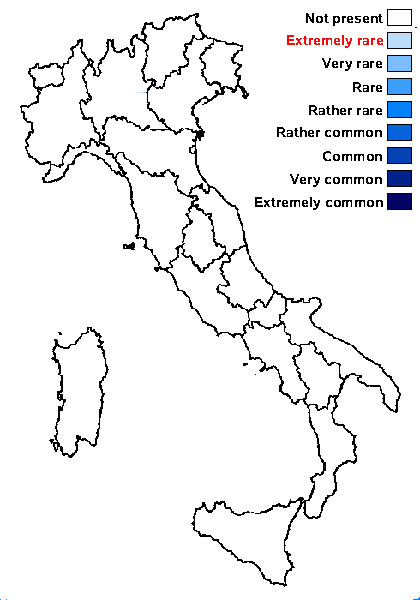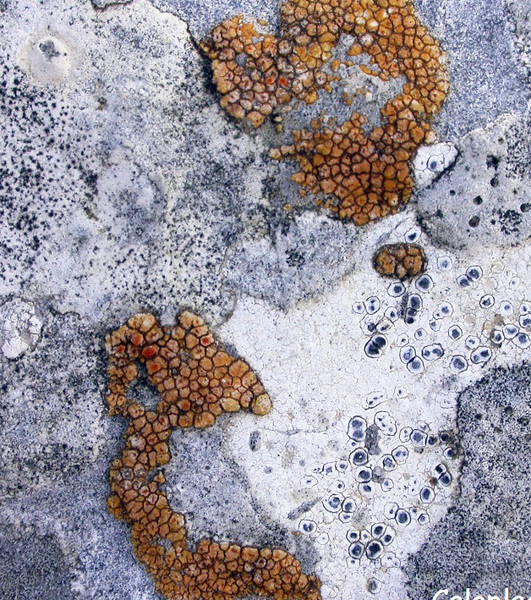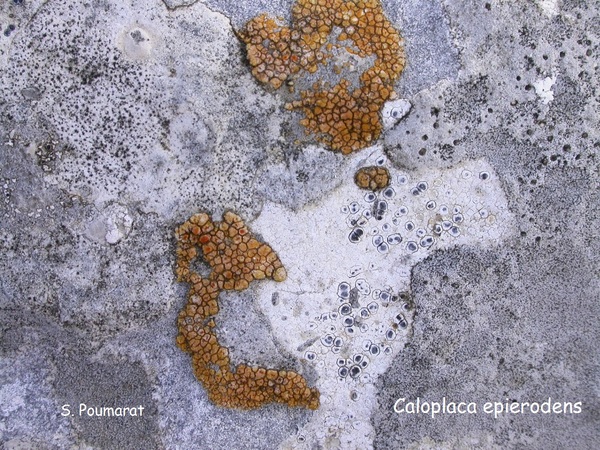Variospora epierodens (Cl. Roux & M. Bertrand) Cl. Roux & M. Bertrand
In Roux & al., Bull. Soc. linn. Provence, 72: 174, 2021. Basionym: Caloplaca epierodens Cl. Roux & M. Bertrand - Bull. Inf. Ass. Franç. Lichén., 44, 1: 2, 2019.
Synonyms:
Distribution:
Description: Thallus crustose, episubstratic, areolate or verrucose-areolate, salmon orange, forming 0.4-1.5 cm wide patches on the thalli of Pyrenodesmia erodens, the areoles contiguous, flat to convex, 0.2-0.8(-1.1) mm wide, 0.15-0.5 mm thick, separated by deep cracks. Apothecia 0.2-1 mm across, orange to orange-red, with a concolorous or slightly paler margin. Epithecium orange, K+ purple-red; hymenium and hypothecium colourless. Asci 8-spored, clavate, functionally unitunicate, apically thickened with a broad internal beak, the inner part of apex and external cap I+ blue, Teloschistes-type. Ascospores 2-celled, polarilocular, hyaline, ellipsoid to broadly ellipsoid, 9.5-16.5 x 5.5-10.5 µm, the equatorial thickening (“septum”) 2-5.5 µm. Photobiont chlorococcoid. Spot tests: thallus and apothecia K+ purple-red, C-, KC-, P-. Chemistry: Chemistry: thallus and apothecia with parietin (major), fallacinal, emodin, teloschistin and parietinic acid (minor), corresponding with chemosyndrome A of Søchting (1997).Note: a recently-described species starting the life-cycle on Pyrenodesmia erodens (see Roux & Bertrand 2019); to be looked for in Italy.
Growth form: Crustose
Substrata: rocks
Photobiont: green algae other than Trentepohlia
Reproductive strategy: mainly sexual
paras Pyrenodesmia erodens
Commonnes-rarity: (info)
Alpine belt: extremely rare
Subalpine belt: extremely rare
Oromediterranean belt: extremely rare
Montane belt: extremely rare
Submediterranean belt: extremely rare
Padanian area: absent
Humid submediterranean belt: extremely rare
Humid mediterranean belt: absent
Dry mediterranean belt: absent

Predictive model
Growth form: Crustose
Substrata: rocks
Photobiont: green algae other than Trentepohlia
Reproductive strategy: mainly sexual
paras Pyrenodesmia erodens
Commonnes-rarity: (info)
Alpine belt: extremely rare
Subalpine belt: extremely rare
Oromediterranean belt: extremely rare
Montane belt: extremely rare
Submediterranean belt: extremely rare
Padanian area: absent
Humid submediterranean belt: extremely rare
Humid mediterranean belt: absent
Dry mediterranean belt: absent

Predictive model
 INDEX FUNGORUM
INDEX FUNGORUM
 GBIF
GBIF



